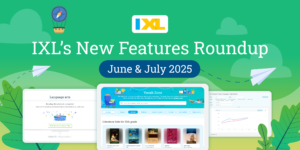At IXL, we never stop adding new features and skills to our award-winning teaching and learning platform, so you can always trust we’re on pace with students’ evolving needs. That’s why we compile a list of our top new features to help you—as a learner, educator, or parent—get the most out of IXL.
Keep reading below for a roundup of releases from June and July, including the LevelUp Diagnostic for ELA, vocabulary resources from Vocabulary.com, the LevelUp Benchmark Growth report, and more! To stay current with our latest updates, follow IXL on Facebook, Instagram, X, and LinkedIn.
Table of contents:
- Major releases
- Feature updates
- Retakes for custom assessments
- Scheduling suggested skills
- Assessment hours for Common Assessments
- Checkpoints for grades 6 and 7
- Diagnostic recommendations in teacher reports
- View last year’s benchmark data in Analytics
- Language support for 100+ languages
- Audio support for 70 languages
- Language support extended to more features
- IXL Minis view tracker for admins
- LevelUp high school math standards report for MD and NJ
- IXL iOS app updates
- StudyWise plan MAP score upload for admins
- Suggested skills improvements
- Skill plan updates and new skills
- Additional releases
Major releases
LevelUp™ Diagnostic for Pre-K-12 ELA
The LevelUp™ Diagnostic now supports ELA for grades PK-12! Like the LevelUp Diagnostic for PK-12 math, the LevelUp ELA Diagnostic is a rigorous, standards-aligned assessment built on cutting-edge psychometric principles. It’s the only comprehensive assessment solution that provides always-up-to-date data and personalized next steps—just when you need them.
In as little as 45 minutes (and no more than one hour), the LevelUp ELA Diagnostic provides standards-aligned benchmarking data and identifies students who may be at risk of reading difficulties. Each student receives a personalized action plan immediately after the test, and teachers can continuously refine students’ scores and action plans year-round using the LevelUp Diagnostic in Real-Time mode.
The LevelUp ELA Diagnostic also offers unparalleled flexibility when evaluating student performance with distinct Reading and Writing & Language scores. Administrators can pinpoint PreK-12 students’ Reading levels with the default 1-hour Reading Benchmark. For a deeper layer of insight into ELA proficiency, administrators can also assign the additional 1-hour Writing & Language Benchmark to students in grades 2-12. When taken together, the full ELA Benchmark can be completed in 90 minutes, with a 2-hour limit.
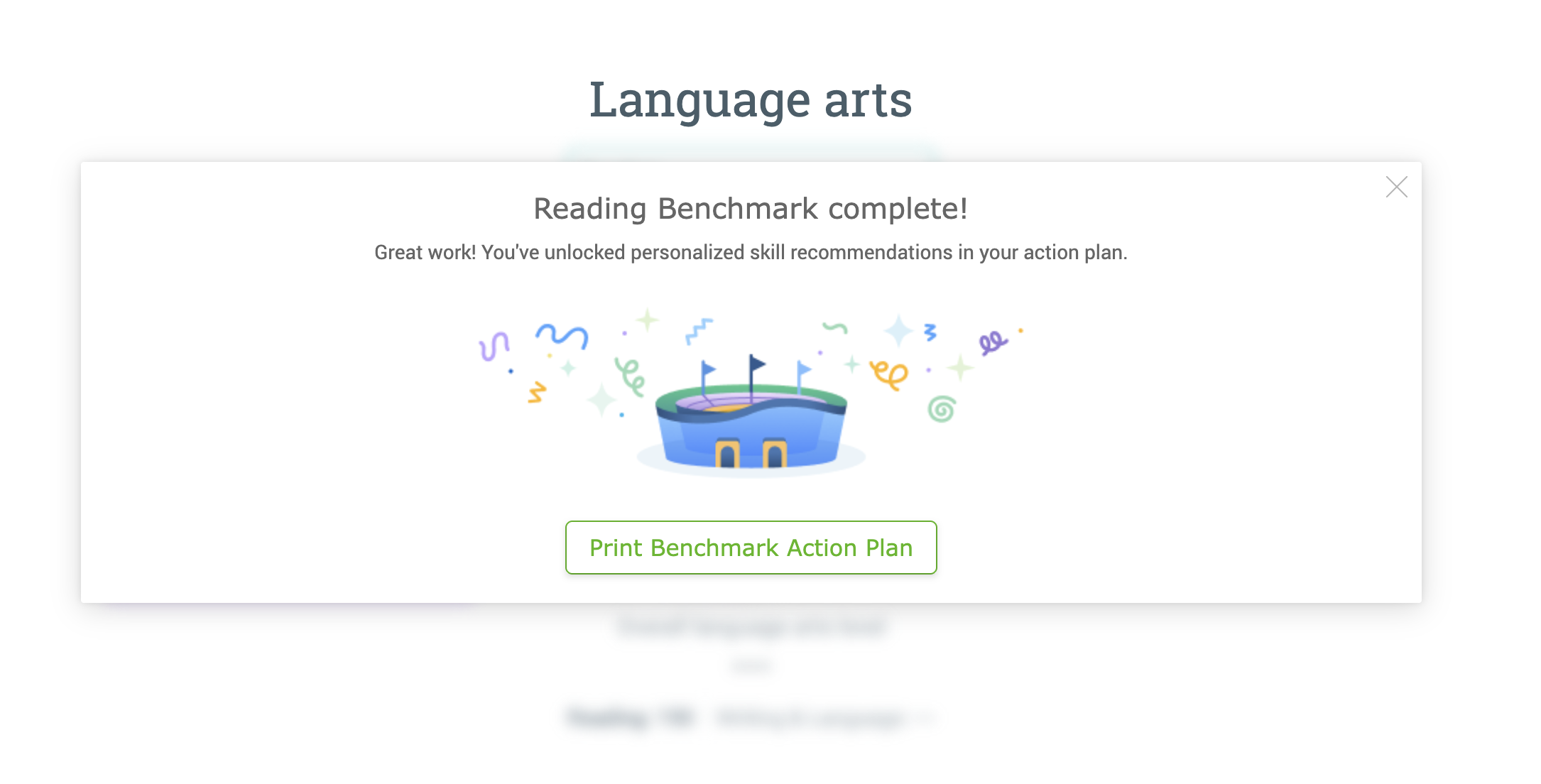
Vocab Zone and Vocabulary.com access
IXL Language Arts now includes award-winning vocabulary learning tools from Vocabulary.com! This partnership offers middle and high school educators a ton of resources to enrich vocabulary instruction, which supports better literacy outcomes for students.
IXL’s new Vocab Zone collects thousands of word lists aligned to popular novels, test prep, and commonly covered topics for middle school and high school. Once you’ve found the list you’re looking for, you can assign vocabulary flashcards to your students to help them review independently.
Plus, educators and 5th- through 12th-grade students also have full access to the whole catalog of collaborative, adaptive activities on Vocabulary.com! This includes Vocab Jams, Quizzes, the VocabTrainer, and 17,000 word lists to supercharge lexical learning. Learners and educators can also see student progress and class reporting.
If a school doesn’t want students to have Vocabulary.com access, primary and lead administrators can disable access for all users on their IXL account from the “Product access” section in their settings.
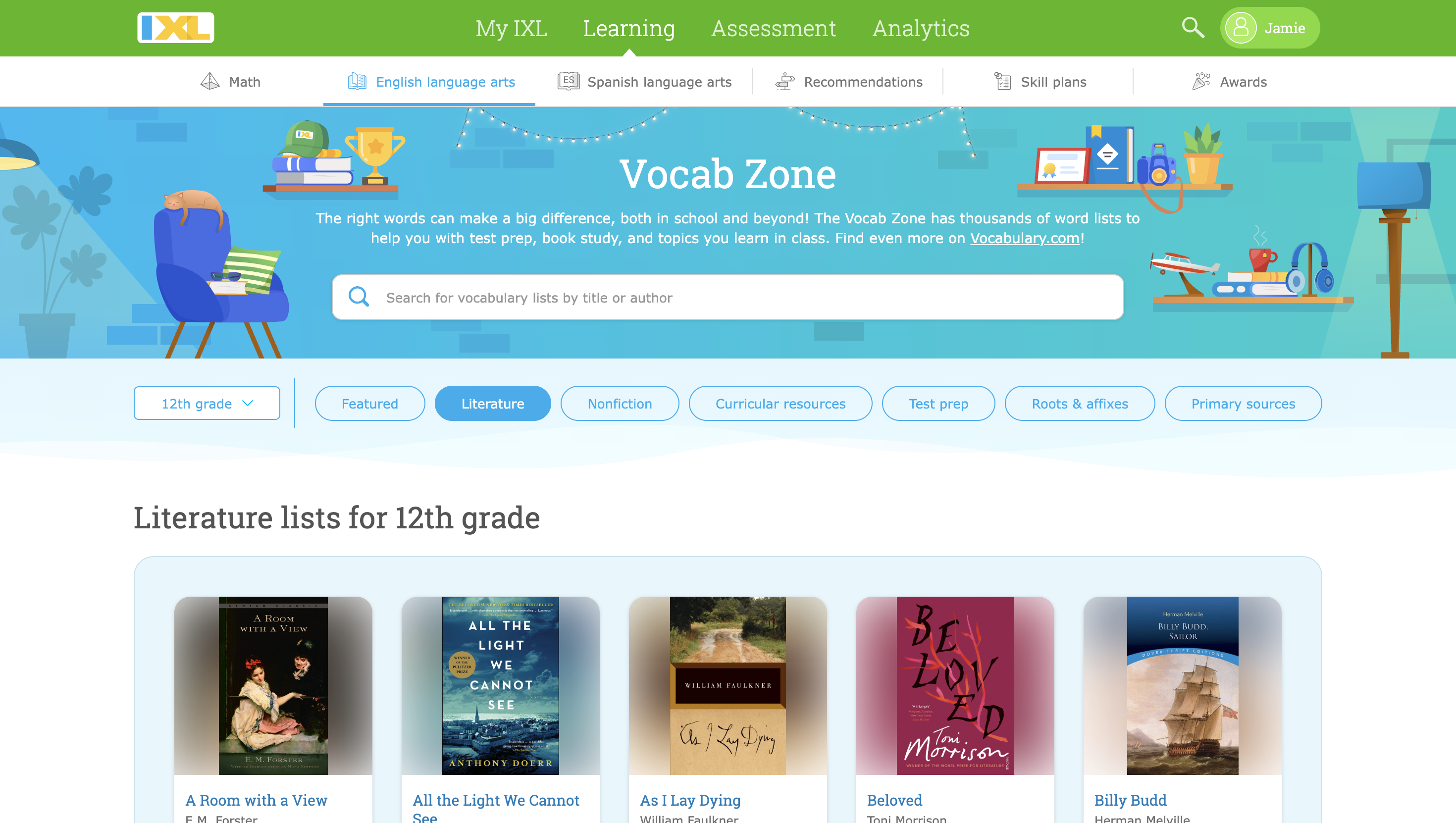
LevelUp Benchmark Growth report
IXL has a new report to help administrators track student growth over time and pull useful insights from their Diagnostic data: the LevelUp Benchmark Growth report!
This report shows administrators their students’ average Benchmark score for every Benchmark window across the school year, similar to the Flex Benchmark Growth report. This report is particularly great at showing whether students are reaching performance goals, both overall and in key strands.
The LevelUp Benchmark Growth report defaults to showing data for the current year, but administrators can also choose to see past year data in this report. Additionally, administrators can group this data by demographics, courses, teachers, and schools (district accounts only).
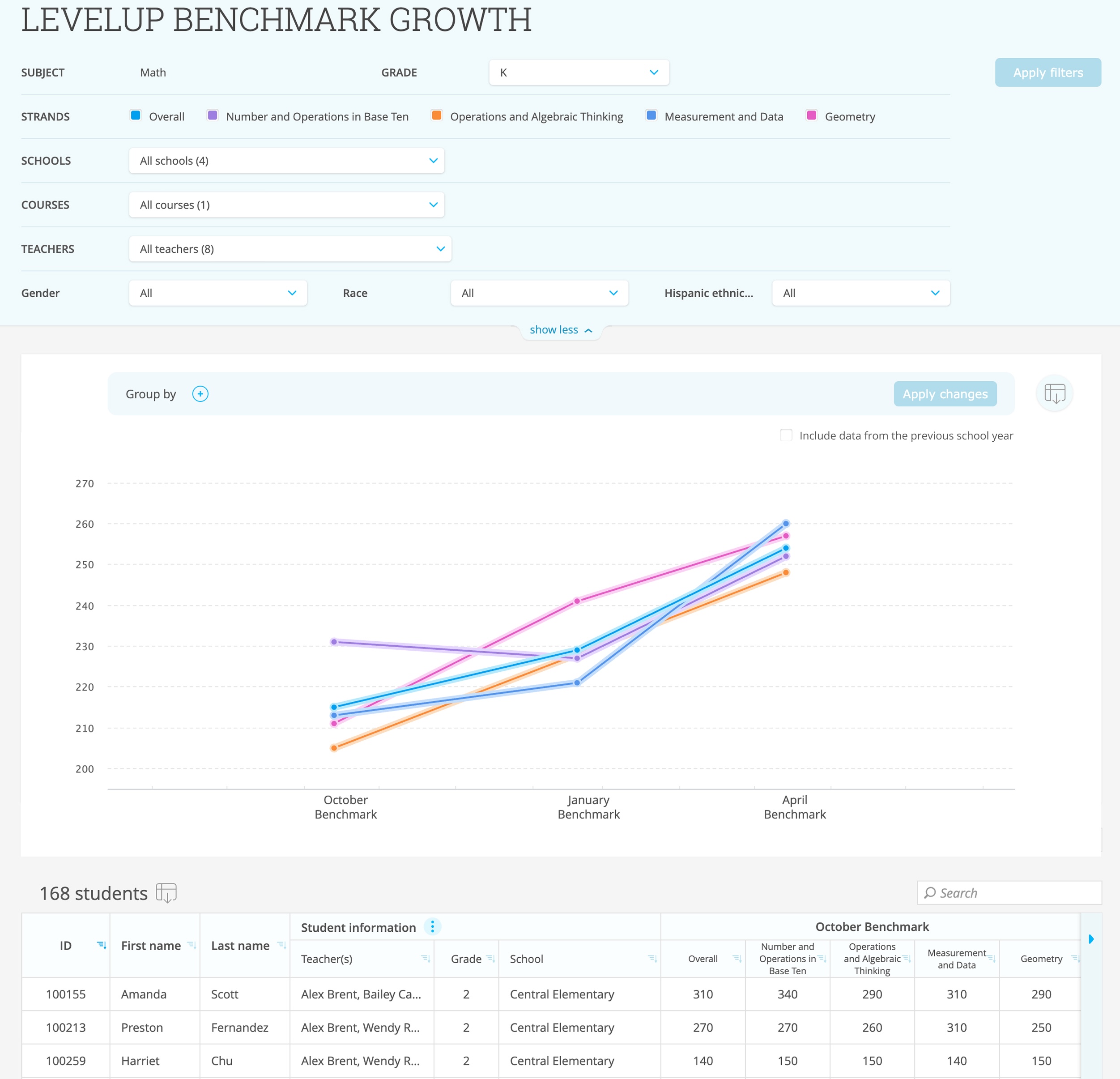
Summary Report for families
Family accounts on all English editions now have a new Summary Report, which highlights Diagnostic growth, progress on skills, and areas to focus on next. The report provides a clear and comprehensive snapshot of a child’s progress on IXL.
Both parent and child users can see the Summary Report by navigating to Analytics. It’s accessible by clicking the “Summary” tab, and it’s the first report that appears by default.
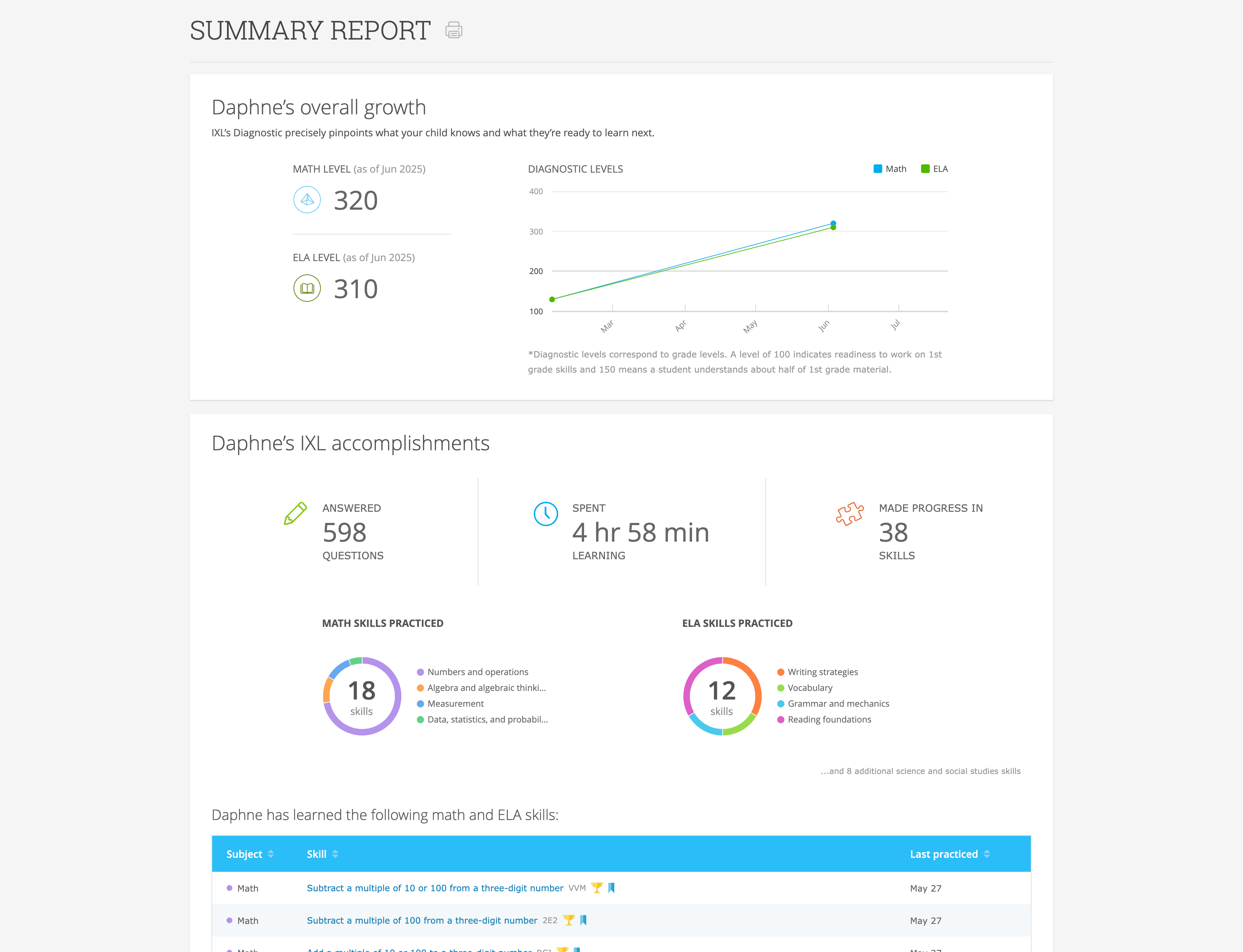
Feature updates
Retakes for IXL Quizzes and Common Assessments
Teachers and administrators can now assign retakes for IXL Quizzes, Quiz Library resources, and Common Assessments! This gives educators the flexibility to reassign assessments for credit recovery, as well as help students who submit their assessments too quickly.
Teachers can assign retakes for their own IXL Quizzes and Quiz Library Resources by selecting the “Assign retake” button in the top right of a student’s Student Quiz Results report. Administrators can assign retakes for Common Assessments by going to the student tables below the Common Assessment Results and Common Assessment Item Analysis reports, and selecting the “Retake” icon to the left of a student’s ID.
After students submit a retake, their new score will replace their original score in the same reports as other students who completed that assessment, keeping all assessment data in the same place.
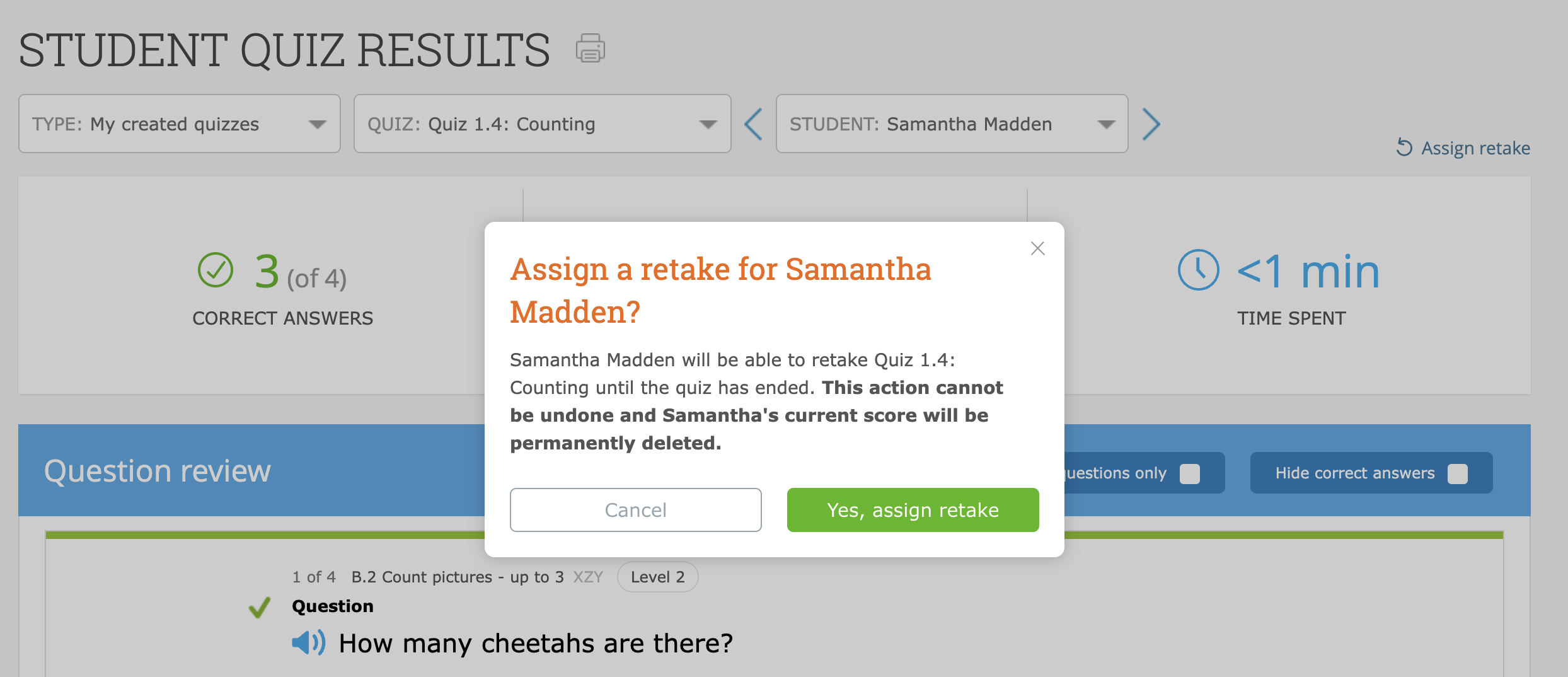
Scheduling suggested skills
Teachers can now schedule suggested skills so that they appear on students’ dashboards at a designated time. This makes lesson planning easier and more organized, ensuring students are working on the right content at the right time.
When teachers find a skill they’d like to schedule ahead, they can select the star button like they’d normally do to suggest a skill. Once they choose which classes or students to suggest the skill to, they can select the calendar icon to pick the date and time they want the skill to appear.
Skills teachers have scheduled will appear on their teacher dashboards, listed separately from active suggested skills.
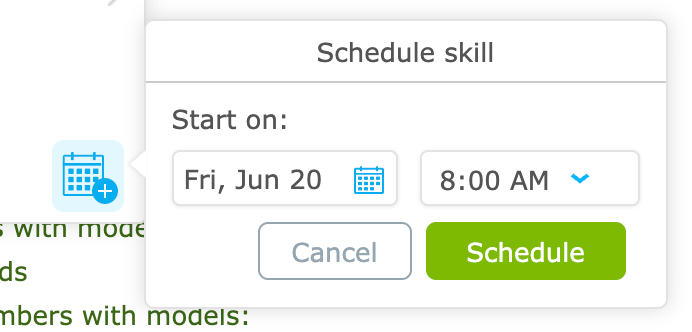
Assessment hours for Common Assessments
Administrators can apply their school’s assessment hours to IXL Common Assessments! Applying assessment hours will make it so students can only answer questions in the Common Assessment on weekdays during the school’s designated assessment time. This gives administrators more control over when Common Assessments are accessible to students, supporting more intentional assessment practices.
On the Common Assessments dashboard, moon icons will appear next to assessments that are using assessment hours to indicate which assessments are available to students:
- Filled moon: Outside assessment window; students are prevented from taking the Common Assessment.
- Empty moon: Inside assessment window; assessment hours are turned on, but students are able to take the assessment as the current time is within the window.
- Striped moon (district only): Some schools are within the window, but others are not.
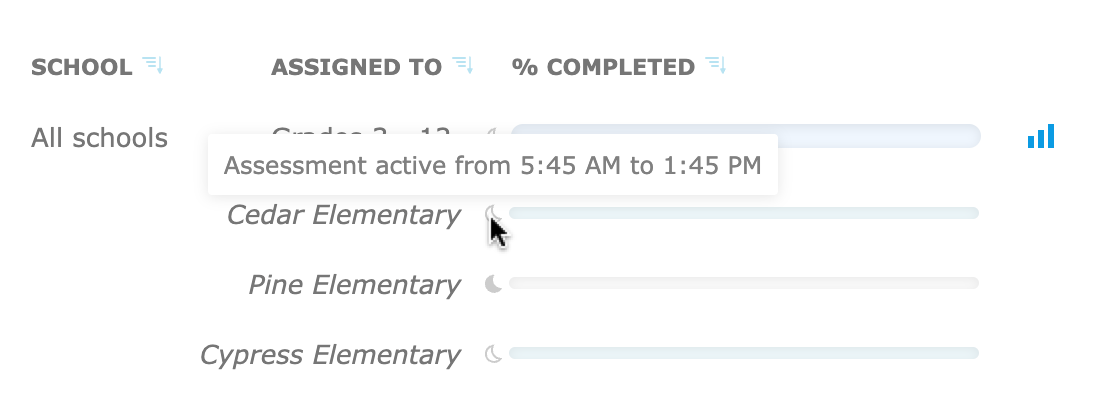
Checkpoints for grades 6 and 7
Checkpoints are rigorous mini-assessments that challenge students to apply their knowledge from multiple skills and standards at once. They’re perfect for getting students ready for end-of-unit and high-stakes tests, and now they’re available for 6th and 7th grade math in addition to 8th grade math, Algebra 1, and Geometry!
As students work through Checkpoints, IXL identifies their specific knowledge gaps and then points them to the exact foundational skills to close them. Find Checkpoints on the grade 6 and grade 7 math skill pages, marked with a blue flag icon.
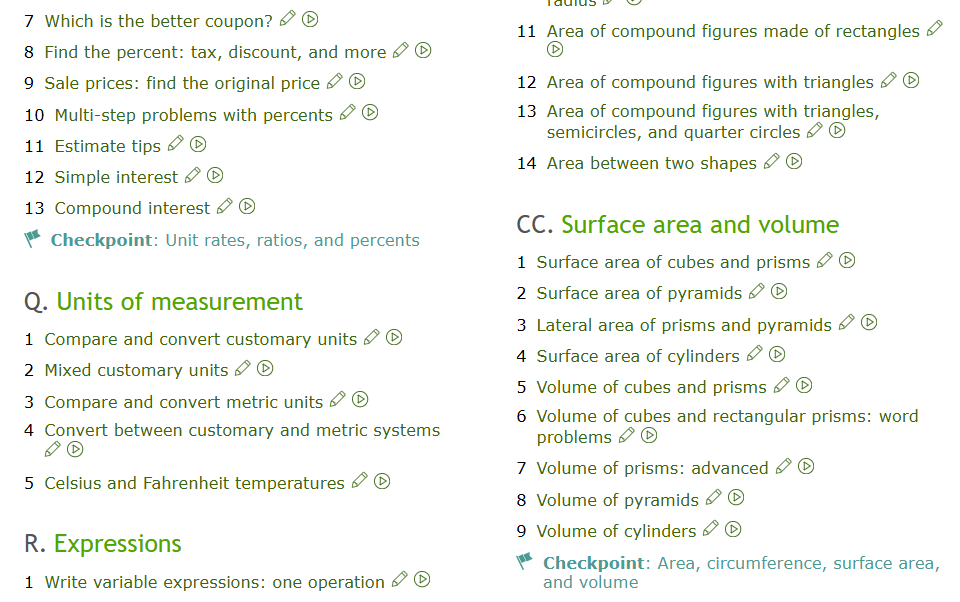
Diagnostic recommendations in teacher reports
Teachers have a new way to track which skills students have practiced from their Diagnostic Action Plans! A flag-shaped icon will now appear next to skills students practice that are recommended by their Action Plans.
This flag icon appears next to skill practice in the Students Quickview report, Student Usage report, and Live Classroom. Diagnostic Action Plans are a core part of many teachers’ implementation of IXL, and this update makes it easier than ever to make sure students are following them.
Additionally, the Students Quickview report has a new dropdown filter that lets teachers see only Diagnostic recommendations, suggested skills, or both.

Last year’s LevelUp Benchmark data in IXL Analytics
Administrators and teachers can now see LevelUp Benchmarks from the previous school year! This gives educators context around how students performed last year.
Administrators can find this data in the LevelUp Diagnostic Results and the LevelUp Standards Performance reports, while teachers can find it in the LevelUp Diagnostic Overview and LevelUp Diagnostic Standards Performance reports.
IXL’s language support reaches over 100 languages
IXL now provides language support for 100+ languages, enabling all students to make progress in essential skills, even if they are still building their English language abilities.
We recently added support for additional languages:
- Kazakh: A Turkic language spoken in a number of Central Asian countries.
- French (Canada): A dialect of the French language spoken in Canada.
- Portuguese (Portugal): A Romance language originating in the Iberian Peninsula of Europe.
- Inuktut (Syllabics): An Inuit writing system used in the Canadian territory of Nunavut and the Nunavik region of Quebec.
- Hawaiian: A Polynesian language originating in the Hawaiian Islands.
- Lithuanian: A Baltic language used in Lithuania.
- Mauritian Creole: A French-based creole language spoken in Mauritius.
- Norwegian: A North Germanic language spoken principally in Norway.
- Punjabi (Shahmukhi): An Indo-Aryan language native to the Punjab region of India and Pakistan.
- Sinhala: An Indo-Aryan language primarily spoken by the Sinhalese people, the largest ethnic group in Sri Lanka.
To turn on language support for learners, go to your Profile & Settings page and “Enable translation support” for select students.
Audio support for 70 languages
IXL’s audio support now extends to 70 languages! With the click of a button, students who speak these languages can hear text in IXL math, science, and social studies read aloud. Audio support is available in the following languages:
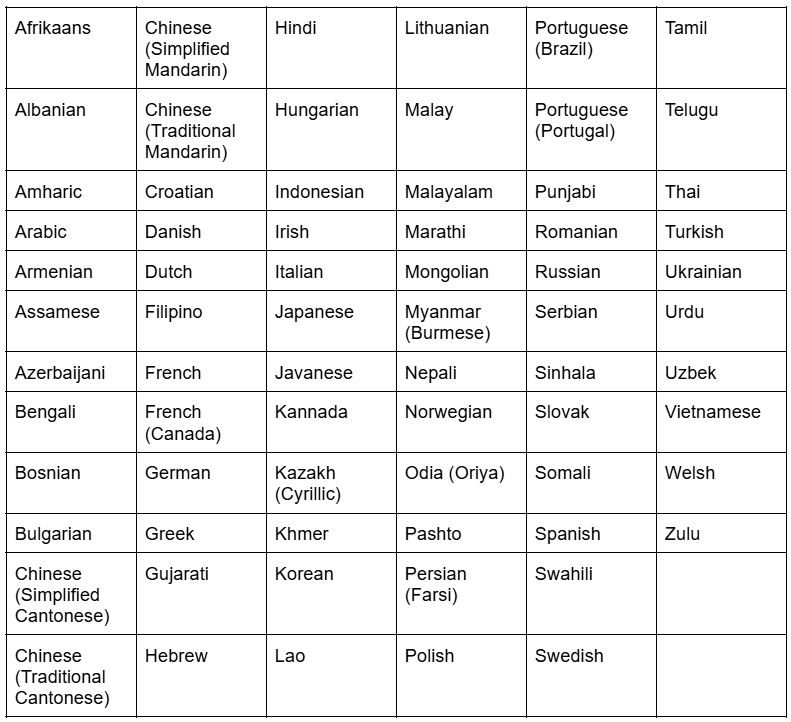
Language support extended to more features
IXL provides comprehensive language support during skill practice, and now English learners will be able to access that support in more features on IXL! This will enable them to better participate in classroom learning and assessment.
The new features with language support are:
- Group Jams and Lightning Jams
- IXL Quizzes
- Common Assessments
- Quiz Library Resources
- Takeoff assessments
Any languages that have audio support will also have audio support in these features as well.
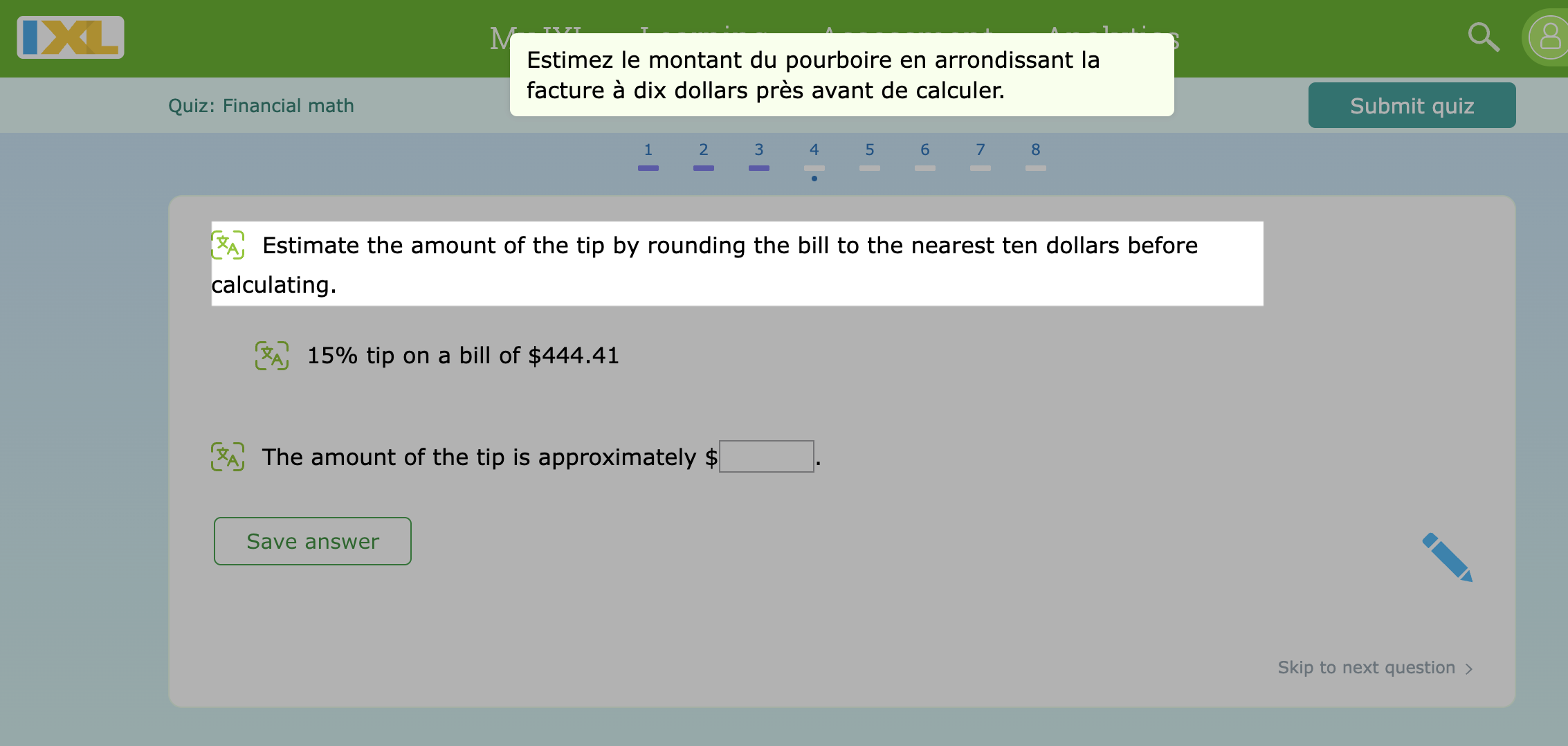
IXL Minis view tracker for administrators
School-level administrators can now see which teachers are watching IXL Minis, how much time teachers are investing into these bite-sized professional development videos, and which Minis are most popular.
IXL Minis are a great resource for educators to quickly learn about IXL’s top features and how to use them to enhance their instruction. This addition to the IXL Minis page will make it easier for administrators to support professional learning and see which topics teachers are exploring!
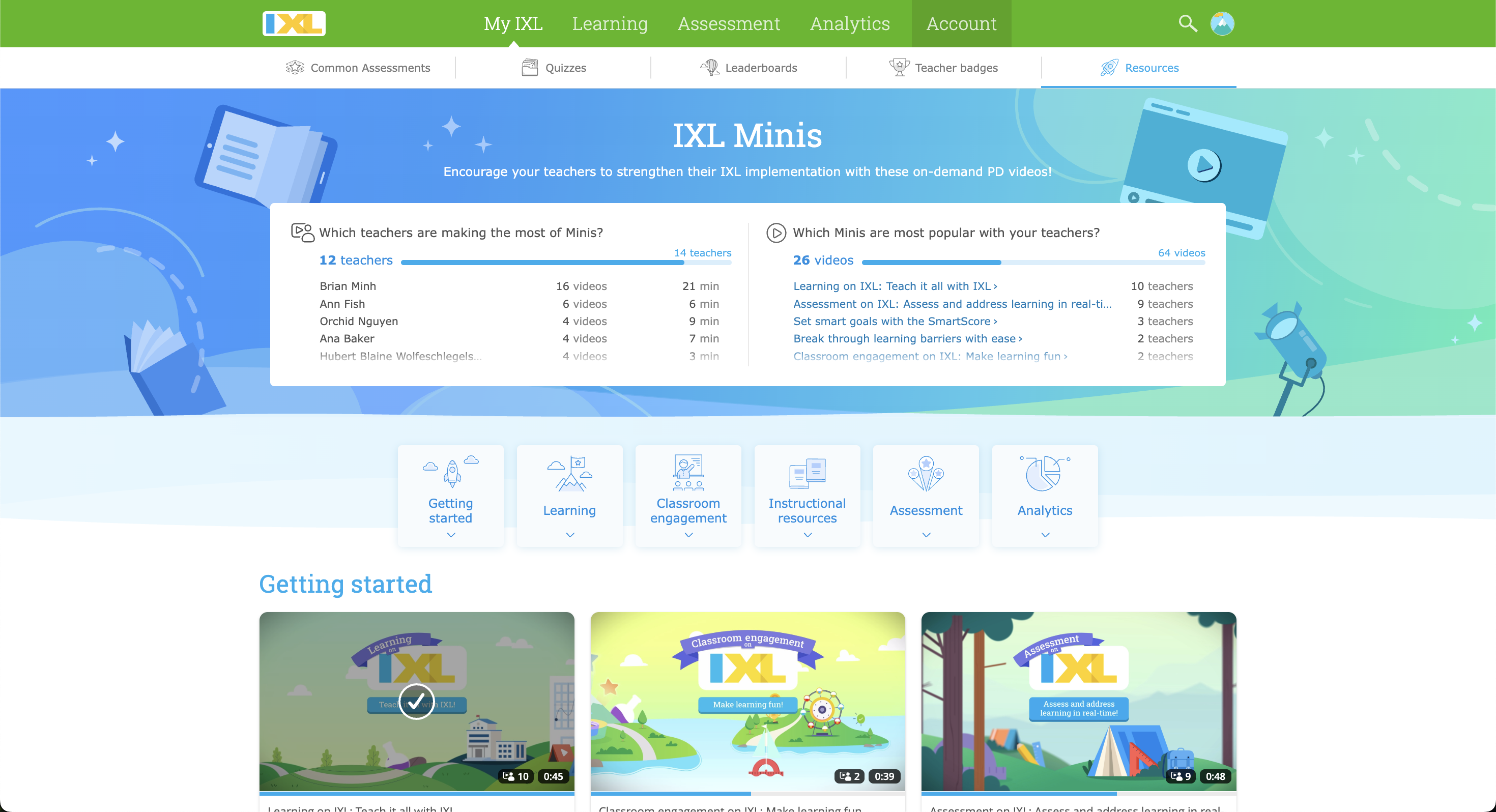
LevelUp high school math standards report for Maryland and New Jersey
We’ve released standards reports for the LevelUp Math Diagnostic for Maryland and New Jersey high school math standards. For both states, the courses included are Algebra 1, Geometry, Algebra 2, and Integrated I, II, and III. The report was previously available for Kindergarten through Grade 8. We will continue to release additional states’ high school standards reports in the coming months.
IXL iOS app updates
The IXL app for iOS devices now supports two new IXL features, giving students more freedom to work on IXL using their platform of choice. The new features are:
- Lightning Jams: Students using the IXL app for iPad can now join Lightning Jams, where they can answer questions with their classmates and see the Jam’s top scores.
- SmartScore goals: Students using the IXL app for iPad and iPhone can now see SmartScore goals set by their teachers. Also, when they reach a goal, they’ll get a fun celebratory animation.
StudyWise plans NWEA MAP score uploading for administrators
Administrators can now upload a CSV file of their students’ MAP scores to IXL StudyWise, making it easier for schools and districts to create personal study plans for their students. Primary and lead admins can navigate to the NWEA MAP Growth program from the skill plans page and select “Manage student study plans.” Instructions will guide you through the rest of the process.
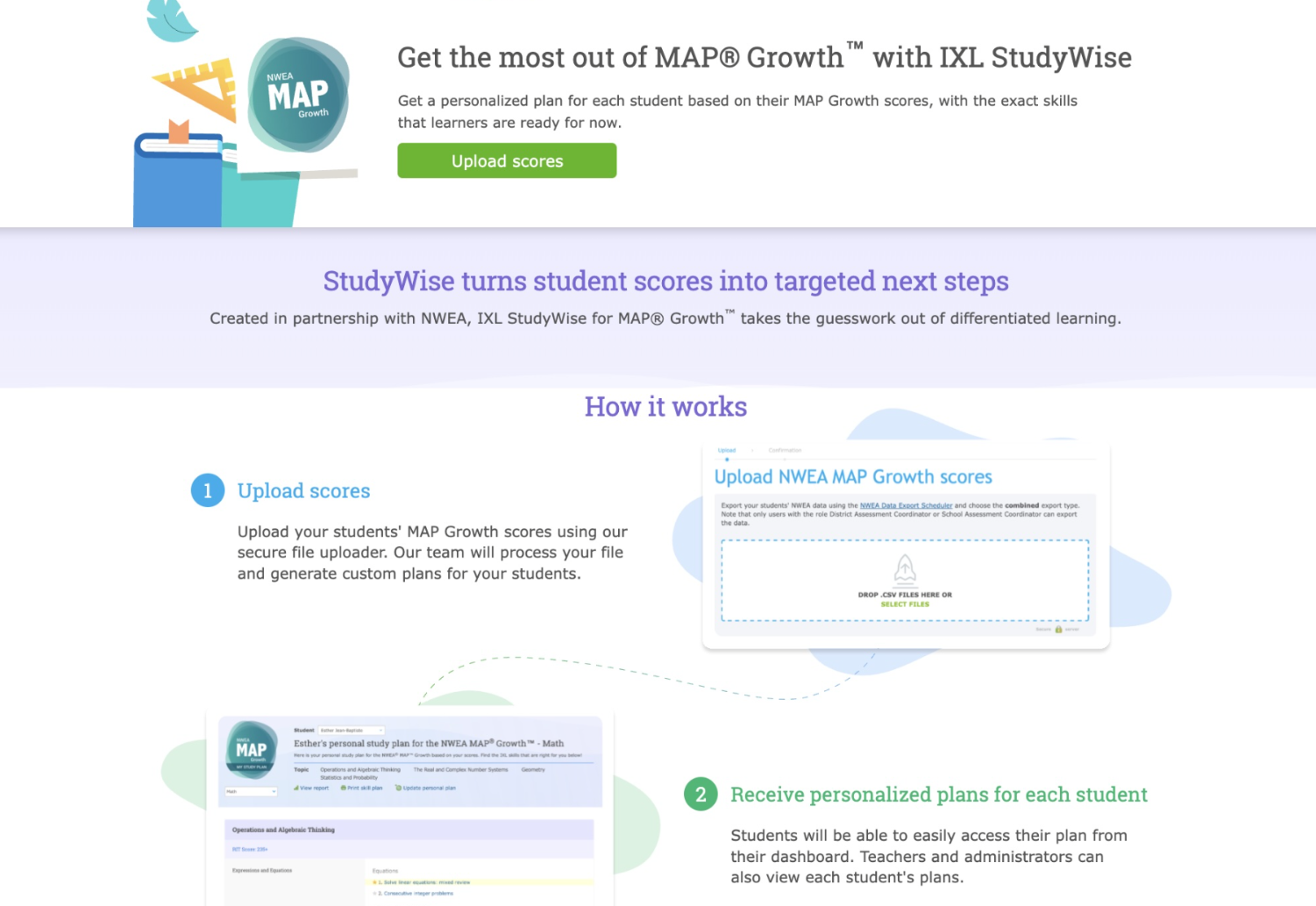
Suggested skills improvements
Suggested skills have been improved in a number of ways to make them easier and more efficient for teachers to use:
- Teachers can now open the class/student list by clicking the suggested star icon, instead of hovering over it. This should reduce the likelihood of errors when modifying a suggested skill, and make it easier to suggest skills on phones and tablets via a web browser.
- For teachers with classes set up, hovering over a class will now open the student list to the side, allowing for quick selection of students.
- To clear a suggestion, teachers can use the “Clear” option in the class/student list or a hover tooltip.
Family users with multiple children on their subscription will also see these improvements, allowing them to more easily suggest skills for specific children.
Skill plan updates and new skills
New math skills
We’ve released new math skills, spanning kindergarten through Calculus:
- Compare numbers up to 20 using number lines (Kindergarten)
- Estimate lengths with inches, feet, and yards (Grade 2)
- Sort three-dimensional shapes (Grade 2)
- Regroup thousands, hundreds, tens, and ones – ways to make a number (Grade 3)
- Measure liquid volumes using half and quarter cups (Grade 3)
- Divide using arrays: write remainders as fractions (Grade 4)
- Equations with mixed operations: true or false (Grade 4)
- Multiply fractions and mixed numbers: multi-step word problems (Grade 5)
- Write exponential functions from tables and graphs (Algebra 1)
- Divide polynomials using long division (Algebra 2)
- Find critical points of functions (Calculus)
- Find local extrema using the first derivative test (Calculus)
- Areas of regions bounded by graphs and the x-axis (Calculus)
- Solve first-order initial value problems (Calculus)
For our first-grade students in Florida, we are releasing a new skill on subtraction using a hundred chart. Additionally, we have enhanced the questions and explanations in several existing skills, including Add two numbers – sums up to 10 for kindergarten and Classify triangles for grade 5.
New English language arts skills
We’ve added over 120 new spelling skills to IXL! These skills range across grades 2-12 and cover spelling patterns with prefixes, roots, and affixes, as well as common spelling words in each grade. Here are a few examples:
- Use spelling patterns to sort long a words (Grade 1)
- Spell words with base elements: bio, geo, graph, logy, photo, scope, tele (Grade 9)
- Learn to spell words with prefixes: anti-, non-, post- (Grade 11)
Additionally, we’ve added 20 new letter identification review skills in PK-K, such as Review the letters A-D. These review skills help students recognize the letters they’ve learned in skills that focus on individual letters, providing support as they practice identifying both uppercase and lowercase letters.
Finally, we’re building our library of decodable text skills with two new skills for first and second grade, specifically designed for mastering the silent e pattern. Like our other decodable text skills, these include delightful illustrations and engaging stories that make learning fun!
New Spanish language arts skills
We’ve added several new Spanish language arts skills in grades 3, 4, and 5! Here are a few highlights:
- Símiles con imágenes (Similes with images): Students match delightful similes with captivating illustrations.
- Determinar los temas de mitos, fábulas y cuentos populares (Determine the themes of myths, fables, and folktales): Students read creative retellings of well-known myths, fables, and folktales. They are then asked to identify the themes of these engaging stories.
- Leer sobre animales (Read about animals): Students read and answer questions about compelling, nonfiction texts on penguins, octopi, poison dart frogs, and more!
- Identificar símiles y metáforas (Identify similes and metaphors): Students dip their toes into the sea of figurative language and decide if sentences like Este año se pasó como una estrella fugaz (This year passed like a shooting star) are examples of símiles or metáforas!
New science skills
We’ve released a few new high school science skills:
- Osmosis (Biology): Students interpret eye-catching diagrams as they apply their understanding of passive transport to describe how water will move via osmosis in a U-shaped tube.
- Explore intermolecular forces and kinetic energy in phase diagrams (Chemistry): Students analyze phase diagrams to explore the relationships between pressure, temperature, kinetic energy, and intermolecular forces in the context of real examples.
- Multiply and divide with significant figures (Chemistry): Students practice using significant figure rules to multiply and divide measurements, and to express their calculated values with the correct number of significant figures.
- Name ionic compounds containing polyatomic ions (Chemistry): Students are shown a chemical formula and asked to identify the name of the polyatomic ionic compound.
- Calculate the volume of a gaseous reactant or product at STP (Chemistry): Students practice using stoichiometry to calculate the volume of a gaseous reactant or product at standard temperature and pressure, based on a balanced chemical equation and the volume of one gaseous species in the reaction.
New social studies skills
We’ve released ten new skills for social studies:
- George Washington Carver, Harriet Tubman (Grades K-3): Students learn about the lives and accomplishments of these two American figures. These skills are brand new for kindergarten and grade 1, featuring read-along highlighting to support emerging readers. In grades 2 and 3, we’ve revamped our existing skills to include passages for deeper exploration.
- Political participation (Civics): Students learn about how people can participate in the American democracy, from registering to vote to running for office.
- Authoritarian and democratic governments (Civics): Students learn about these two types of governments through the concepts of power, authority, and legitimacy. Students then apply their knowledge by comparing real-world examples.
- Labor in the Gilded Age (U.S. History): Students learn about Gilded Age working conditions, including efforts to improve working conditions and conflicts between business and labor.
- Civil rights movement: school desegregation (U.S. History): Students learn about the legal cases challenging school segregation, as well as how states resisted desegregation.
- Introduction to the Cold War (U.S. History): Students learn about the origins of the Cold War. Students will analyze the U.S. government’s policy of containment, including the Truman Doctrine, Marshall Plan, and the Berlin Airlift.
- The presidency of John F. Kennedy (U.S. History): Students will analyze Kennedy’s life, his approach to the Cold War, his response to domestic issues like civil rights, and the significance of his assassination.
- World War I: the home front and the battlefront (U.S. History): Students learn about the war’s impact on American civilians, as well as how new technology transformed the battlefield.
New textbook skill plans
We’ve released skill plans for the following textbooks:
Math:
- Oxford MYP Mathematics (UK edition) (Years 1-3, 4-5 standard, and 4-5 extended)
Science:
- McGraw Hill Tennessee Science (Grades K-8)
- Savvas Elevate Science Tennessee (Grades 6-8)
New standards skill plans
We’ve released skill plans for the following standards:
- Tennessee Academic Standards (2022) (Science grades K-8, Biology I, and Chemistry I)
- Oregon Social Science Standards (2024) (Social studies grades K-8, U.S. History, Civics)
- American Samoa Calculus
Fall Power-Up Spotlight plans for math and ELA
Our Fall Power-up skill plans are back! These plans provide 20 days of math and ELA skill recommendations for students in grades K-12 and focus on reviewing and extending knowledge from the previous year to set students up for success, offering a perfect opportunity to start the school year strong.
Additional releases
New math and ELA video tutorials
Math:
We’ve released 50 new math videos across Pre-K through Calculus to expand our coverage! These videos cover topics such as solving multi-step addition and subtraction word problems and comparing populations using measures of center and spread.
We’ve also added Spanish subtitles to 32 more math videos. Like translated skills, translated subtitles are available to users with Spanish support enabled.
ELA:
We’ve released 7 new Reading Foundations videos across grades PK though 1, and 8 new ELA videos across grades 3 through 5! These videos cover topics such as learning the letter B and identifying and correcting plagiarism.
Additionally, we’ve added video tutorials to over 150 ELA skills that only appear in skill plans across grades PK-8. Check one out here.
For IXL Canada, we’ve released 5 new localized math videos across grades 4-12!
IXL Minis for the UK
IXL Minis are fun, bite-sized videos that offer teachers expert tips to take their IXL implementation to the next level. Now, UK teachers have their own collection of Minis to learn from!
In just one or two minutes, you can find out about IXL’s top resources and get teacher-tested classroom ideas. Here’s an example of an IXL Minis video, led by an education expert:
Updated curriculum alignment and new math skills for Ireland
We’ve released alignments to the latest Ireland Primary Mathematics Curriculum for Jr. Class- 6th Class including updating the landing page to reflect the current curriculum.
We’ve also made significant changes to our skills to reflect updates to their national curriculum: we’ve added over 552 new skills, revised many existing skills, and reorganized the grade level landing pages across Jr. Class through 6th Class. These updates will help administrators, teachers, and students as they transition to using the new curriculum.
New math skills for Canada, the UK, Australia, and New Zealand
We have released new skills for our Canada, UK, Australia, and New Zealand editions! Some examples include:
- In the Canada Grade 1 skill Use addition to subtract – up to 10, students complete an addition fact and then use it to solve a related subtraction fact. This helps students build math fluency and recognize underlying patterns in arithmetic. We have also released this skill for the UK, and New Zealand!
- In the UK Year 2 skill Build and break apart teen numbers, students compose and decompose numbers 11-19, both with and without place value models.
- In the UK Year 2 skill Name the two-dimensional shape and explain your answer, students use their developing familiarity with shapes to both identify a given shape and justify their reasoning. We also released this skill in Australia Year 1 and Canada Grade 1.
We’ve also released UK Year 1 skills on subtracting by counting back, adding by counting on, and adding numbers in any order.
Takeoff alignment to Indiana, Missouri, Pennsylvania, and Tennessee state standards
We’ve added alignments for the Indiana Academic Standards, Missouri Learning Standards, Pennsylvania Core Standards, and Tennessee Academic Standards for math to our K-5 Takeoff curriculum. When signed into a Takeoff account from Indiana, Missouri, Pennsylvania, or Tennessee, users will see their state standards in all the usual places, such as on each grade level’s landing page and at the top of each unit and lesson.
New Takeoff resources
Takeoff has been updated with new resources to help teachers working on math in the classroom, as well as prompts for student reflection.
Math practice alignments and tips:
We’ve expanded our math practice alignments and tips, which provide helpful information to guide math practice for teachers, to 24 more states. The full list of states now includes AL, AK, AZ, AR, CA, CO, CT, DC, DE, GA, HI, IA, IL, KS, KY, LA, MA, MD, ME, MI, MS, MO, MT, NH, NJ, NM, NV, NY, OH, RI, UT, VT, WA, WV, WI, and WY.
Alignments to the Standards for Mathematical Practice will appear in each unit, lesson, mid-unit check-in, and end-of-unit test. These practices describe how students should think, reason, and communicate in math. Our alignments help teachers focus on the right practices at the right time and make it clear which ones are assessed.
Additionally, a new “Math practices” tab on unit outline pages will offer teacher-facing notes on how to support the practices across the unit. These tips explain what actions teachers can take to help students build habits of mind aligned to each lesson.
We’ll be adding math practice alignments and tips for more states over time.
Performance tasks and student self-reflections in Spanish:
Spanish translations are now available for all performance tasks and student self-reflection activities in our National and California editions. We’re excited to offer these resources to support teachers and help Spanish-speaking ELLs succeed in math.
Takeoff California environmental activities in Spanish
Spanish translations are now available for all Environmental Concepts & Principles activities in our California edition of Takeoff. We’re excited to extend our translation support to these resources, further supporting teachers and helping Spanish-speaking ELs succeed in math.
